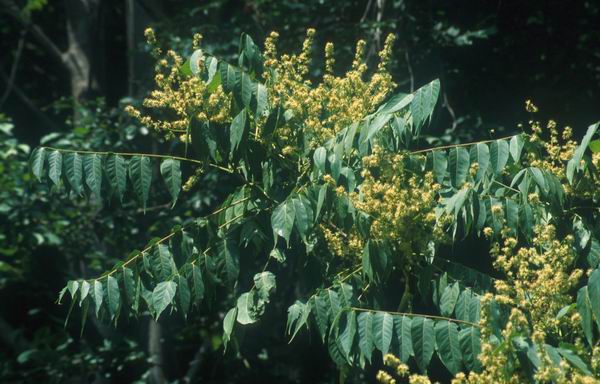
A repost from this blog, ciric May 9, 2006
On Sunday Chris J. pointed to a weedy-looking plant and asked me it's name. "Ghetto Palm," I replied. "The real name is something that has two A's in its name, but I cannot remember it."
Feeling a bit sheepish for forgetting something once again (I spent the day trying to remember the word "locust") I fell back to quoting a pithy phrase from that great urban philosopher, Mr. T: "Don't do drugs -- stay in school."
In truth, my memory is getting as leaky as spaghetti colander (worse on days without too much sleep), and my eyesight is no longer too great. As for my hair, I miss it terribly, especially on cold days.
Back at the house I looked up "Ghetto Palm" and there it was -- Ailanthus altissima -- also called the "Tree of Heaven".
It's a long way from "Tree of Heaven" to "Ghetto Palm," but that's the linguistic path this plant has taken in this country.
Like so many invasive weeds, such as kudzu and multiflora rose, the Tree of Heaven was first imported as an ornamental. A small easy-to-grow tree, it lent a slightly tropical-air to 19th Century American gardens.
Of course it soon got out of the garden, and has been spreading malevolence across the world ever since. About like Adam and Eve, truth be told.
A mature ailanthus tree will produce several hundred thousand seeds a year. This little tree is truely invasive -- not only along the edges of fields, but also on median strips, driveways and even the cracks of sidewalks.
The Ailanthus can grow in almost any kind of soil, from clay to hardpan, from swamp to sandy rock, and it is not fazed in the least by thick, oily smoke from the exhaust of a passing bus. This is a tree that thrives on neglect, lack of water, and even physical abuse. They don't call it a "Ghetto Palm" for nothing.
This tree is a living monument to the tenacity of life in a harsh urban environment, and is, in fact, the star of the children's book, A Tree Grows in Brooklyn.
That said, its hardiness is its only redeeming value. Ailanthus produces no wildlife value at all. Deer will not eat it, and unlike the Staghorn Sumac and Black Walnut, both of which it resembles in appearance, it produces no seeds or nuts of any interest to even the smallest creature, not even a mouse.
The Ailanthus, Staghorn Sumac and Black Walnut have long, palm-like compound leaves but the Ailanthus has little white dots on its new branches and a vertical white stripe or ridge on older trunks, while the dots on a Sumac's young trunk and branches are darker. Sumac leaves are light-colored underneath, and this little tree rarely grows much taller than about 25 feet. In winter, the new buds of Sumac look like they are covered in velvet, a little like a deer antler (hence the name), while Ailantus are simple hard points. Ailanthus branches are arrayed in whorled tiers, while a Sumac has Y-shaped crotches. While Ailanthus leaves turn brown or tan in the fall, Sumac leaves turn bright red -- a very nice display. A Black Walnut tree is easy to identify if it has nuts, of course, but also because this tree develops a very rough and dark craggy bark at a young age-- the easiest way to differentiate it from the other two species of tree.
Though an Ailanthus tree can grow to 80 feet in 10 years, the wood is terribly weak, and so light in weight it burns away in minutes. The branches are spaced in such a way they cannot hold up a bird's nest.
While averse to deep forest shade, Ailanthus commonly dominates forest edges and field hedgerows where it formes a weedy understory when mixed with pokeweed and multiflora rose.
A particular problen with Ailanthus is that the roots can run deep and wreck water and sewage pipes. And while a Tree of Heaven in the side yard may looks pretty in summer, in the dead of winter its trunk is stick-like, and only accents the dreariness of the season.
In Virginia, where I live, some folks call the Ailanthus a "stink tree," because if you crush almost any part of the plant, it has an off-putting odor. The scent is not just offensive to the nose -- the plant is a proven allelopath as well, which is just a fancy way of saying the plant seeps chemicals into the dirt that discourage other plants from taking root. Black walnuts and rhodedendrons do the same thing, of course, but they have at least a few noble properties to serve as a counter-weight, such as nuts and flowers and wood. The Ailanthus, truth be told, is good for nothing but sheer tenacity. This is a tree that cannot be killed by merely hacking it to the ground and plowing it under-- you have to put Round-Up on it,and probably do it more than once.
After everything else on this earth is gone, the Ailanthus (I am quite sure) will be thriving. The weedy will inherit the earth.
.
No comments:
Post a Comment